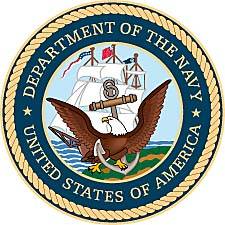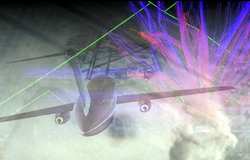 To improve effectiveness and
efficiency, the Navy has started moving toward remote briefing
capabilities to forecast weather to Navy pilots, first via
facsimile and now to Web-based services. The process began in late
2005, and all changes should be fully in place by the end of
2007.
To improve effectiveness and
efficiency, the Navy has started moving toward remote briefing
capabilities to forecast weather to Navy pilots, first via
facsimile and now to Web-based services. The process began in late
2005, and all changes should be fully in place by the end of
2007.
“This is the biggest change in our community since we
merged Navy meteorology and oceanography,” said Rear Adm.
Timothy McGee, commander of the Naval Meteorology and Oceanography
Command here, charged with forecasting the weather for Navy
operations. “It is part of a restructuring specifically
designed to focus Naval Oceanography on warfighting, align our
capabilities toward the Navy’s fighting gaps, and generate
efficiencies through thoughtful application of innovation,
technology and risk.”
The first step has been to take advantage of 21st century
computer communications technology to allow the Navy Oceanography
community to reduce the number of forecasters by providing the same
level of forecasting service from remote locations. These
technology advances allow Navy forecasters to provide weather
forecasts for any region in the world from a satellite office.
Now forecasters are clustered in hubs and distribute weather
forecasts electronically to wherever required. Weather observations
flow to the forecasting hubs from every available source along with
satellite and radar data and numerical weather prediction model
runs.
 This advance also has helped the
Naval Meteorology and Oceanography Command change from regional
subordinate activities to a matrixed framework arranged along
warfighting lines. Gone or going are the six regional forecasting
centers, four regional aviation forecasting facilities and more
than 20 aviation forecasting detachments. As a result, the command
has been able to consolidate a number of leadership positions.
This advance also has helped the
Naval Meteorology and Oceanography Command change from regional
subordinate activities to a matrixed framework arranged along
warfighting lines. Gone or going are the six regional forecasting
centers, four regional aviation forecasting facilities and more
than 20 aviation forecasting detachments. As a result, the command
has been able to consolidate a number of leadership positions.
The command also has embraced an automated observer system,
Automated Surface Observation System (ASOS), for Navy airfields
within the United States.
The command is upgrading ASOS in conjunction with Space
and Naval Warfare Systems Center Charleston to better collect
station observation data and streamline the collection process. The
upgraded systems will be in line with National Weather Service and
Federal Aviation Administration (FAA) systems, and report through a
common network. ASOS cannot yet meet all of the FAA requirements
for station observations, so for now, military observers remain in
place at all Navy airfields in the United States until the function
can be contracted out.
Over the Web, pilots view forecasts/briefs on a system called
Flight Weather Briefer, a system developed at the Naval
Oceanographic Office, the Naval Meteorology and Oceanography
Command’s largest subordinate. Pilots can also receive
forecasts via fax or telephone.

“With the level of sophistication in weather forecasting
today, the continuing improvement through research, not only in the
technology but also in the models and the understanding of the
atmosphere, we have every expectation that weather forecasting will
only get better,” McGee said.
 ANN's Daily Aero-Term (04.28.24): Airport Marking Aids
ANN's Daily Aero-Term (04.28.24): Airport Marking Aids Aero-News: Quote of the Day (04.28.24)
Aero-News: Quote of the Day (04.28.24) ANN's Daily Aero-Linx (04.28.24)
ANN's Daily Aero-Linx (04.28.24) Aero-News: Quote of the Day (04.29.24)
Aero-News: Quote of the Day (04.29.24) ANN's Daily Aero-Linx (04.29.24)
ANN's Daily Aero-Linx (04.29.24)





